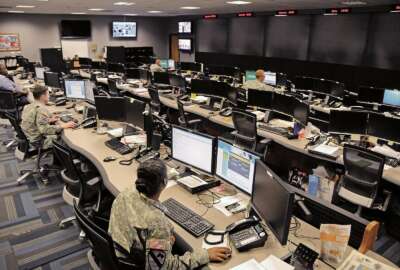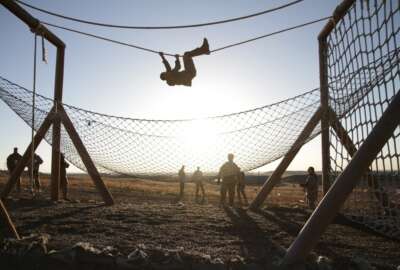Army develops its approach to electronic warfare
Recent studies and exercises have shown that the Army needs a layered approach to EW and that the electromagnetic spectrum should be treated as terrain.
The Army has been reexamining its approach to electronic warfare as recent studies and exercises have shown that the service needs a layered approach to EW and that the electromagnetic spectrum should be treated with the same strategic importance as physical terrain in military operations.
Over the last year, the service conducted multiple studies examining its cyber and electronic warfare resources and capabilities, including the 120-day study conducted by the Cyber Center of Excellence team, followed by a series of classified studies conducted by Georgia Tech Research Institute.
Last month, the service held an EW tabletop exercise at Aberdeen Proving Ground, Maryland, where participants, including I Corps, III Corps, XVIII Airborne Corps and Multi-Domain Task Force, among others, examined over 70 different EW capabilities across the service. The goal was to understand how those capabilities fit into current operational scenarios, identify gaps and develop potential approaches to operational challenges.
“Some of the gaps — it was more of a scenario-based. But fundamentally, just understanding what you look like in the electromagnetic spectrum, what your adversaries look like and how you can be influenced is really one of the the main areas that we walked away from,” Brig. Gen. Ed Barker, program executive officer for intelligence, electronic warfare and sensors, said during a C4ISRnet event Wednesday.
“It really validated that you got to have that kind of layered approach to address those gaps. I think the takeaway was we have to treat the EMS as terrain — you have to be able to hold terrain, you have to be able to maneuver inside of it and you also have to be able to affect the enemy. That was probably the biggest takeaway.”
Due to the unique nature of different operational environments, the U.S. forces can’t rely on a single solution. For example, given particular characteristics of the Pacific theater, air-launched effects, or the ability to deploy EW capabilities from a distance, are needed.
At closer ranges, EW capabilities are needed to protect specific platforms, such as tanks or Bradley Fighting Vehicles, against threats like inbound drones.
“If you want to non-kinetically effect inbound drone to ensure that it misses a tank, that’s similar physics, but the ranges and the outcomes are somewhat different. So you’re doing something in a very long range. And then you’re also, you know, making sure that you can protect those close-in assets,” Baker said.
“From a technical standpoint, it’s definitely a significantly different problem — protecting something within 500 kilometers versus protecting something within the last 500 meters.”
Data challenges
Despite units having to rely on different systems and capabilities depending on their geographical location, they need to be connected to share real-time data and intelligence.
The Army Cyber Center of Excellence is currently conducting an EW pilot to develop a unified EW data architecture that will allow seamless data integration from different sources and regions.
“We have to just be comfortable with the fact that they’re going to be geographically dispersed and have to operate independently, but then also be interconnected. The data conversation is absolutely real – you have to understand the fundamentals underlying data challenges associated with the EW space,” said Baker.
Sharing data with partners
The Army and Marine Corps are conducting a pilot to develop common data standards and capabilities.
The Army recently decided to shift from the Electronic Warfare Planning and Management Tool’s electromagnetic warfare and spectrum management capabilities to the Tactical Assault Kit (TAK) framework, where applications for situational awareness data and geospatial visualizations can be built. The effort is being led by the Electronic Warfare Integration product management office.
“It aligns ourselves with the rest of the fires in the maneuver communities to achieve a commonality across software development, user interfaces, common experiences, underlying data and it’s part of that overall TAK architecture,” said Baker.
Copyright © 2024 Federal News Network. All rights reserved. This website is not intended for users located within the European Economic Area.







